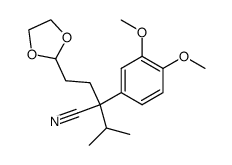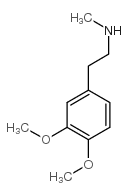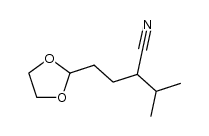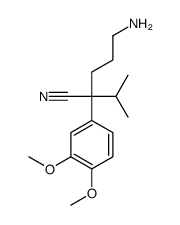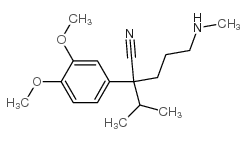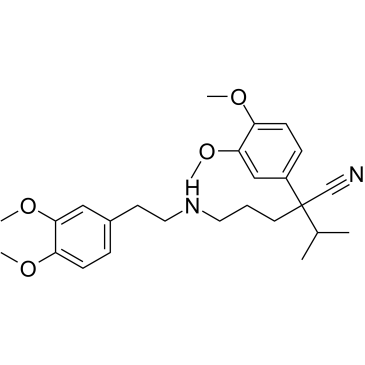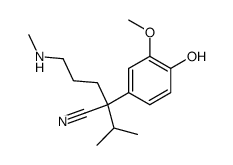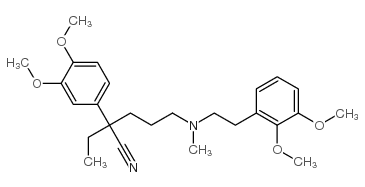52-53-9
| Name | 2-(3,4-dimethoxyphenyl)-5-{[2-(3,4-dimethoxyphenyl)ethyl](methyl)amino}-2-(propan-2-yl)pentanenitrile |
|---|---|
| Synonyms |
eronitrile
aleronitrile 2-(3,4-dimethoxyphenyl)-5-{[2-(3,4-dimethoxyphenyl)ethyl](methyl)amino}-2-(propan-2-yl)pentanenitrile EINECS 200-145-1 5-[(3,4-Dimethoxyphenethyl)methylamino]-2-(3,4-dimethoxyphenyl)-2-isopropylvaleronitrile R,S-Verapamil a-((N-Methyl-N-homoveratryl)-g-aminopropyl)-3,4-dimethoxyphenylacetonitrile Benzeneacetonitrile, α-[3-[[2-(3,4-dimethoxyphenyl)ethyl]methylamino]propyl]-3,4-dimethoxy-α-(1-methylethyl)- Dilacoran Benzeneacetonitrile, α-(3-((2-(3,4-dimethoxyphenyl)ethyl)methylamino)propyl)-3,4-dimethoxy-α-(1-methylethyl)-, (±)- VPL Vasolan a-Isopropyl-a-[(N-methyl-N-homoveratryl)-g-aminopropyl]-3,4-dimethoxyphenylacetonitrile Benzeneacetonitrile, α-(3-((2-(3,4-dimethoxyphenyl)ethyl)methylamino)propyl)-3,4-dimethoxy-α-(1-methylethyl)- Verapamil 2-isopropyl MFCD00056240 (±)-Verapamil D-365 CP 16533-1 2-(3,4-Dimethoxyphenyl)-5-{[2-(3,4-dimethoxyphenyl)ethyl](methyl)amino}-2-isopropylpentanenitrile dl-Verapamil a-[3-[[2-(3,4-Dimethoxyphenyl)ethyl]methylamino]propyl]-3,4-dimethoxy-a-(1-methylethyl)benzeneacetonitrile benzeneacetonitrile, a-[3-[[2-(3,4-dimethoxyphenyl)ethyl]methylamino]propyl]-3,4-dimethoxy-a-(1-methylethyl)- |
| Description | Verapamil ((±)-Verapamil) is a calcium channel blocker and a potent and orally active first-generation P-glycoprotein (P-gp) inhibitor. Verapamil also inhibits CYP3A4. Verapamil has the potential for high blood pressure, heart arrhythmias and angina treatment[1][2][3]. |
|---|---|
| Related Catalog | |
| Target |
Calcium channel[1] Permeability-glycoprotein (P-gp)[1] CYP3A4[1] |
| In Vitro | The EverFluor FL Verapamil (EFV) uptake by TR-iBRB2 cells is inhibited by cationic drugs, and inhibits by verapamil in a concentration-dependent manner with an IC50 of 98.0 μM[4]. |
| In Vivo | Intravenous Verapamil is highly effective in the termination of paroxysmal reciprocating atrioventricular tachycardia, whether associated with preexcitation or involving the atrioventricular node alone[2]. Given orally it is useful for the prophylaxis of atrioventricular reentry tachycardia, and also in modulating the atrioventricular nodal response in atrial fibrillation[2]. |
| References |
[2]. Krikler DM. Verapamil in arrhythmia. Br J Clin Pharmacol. 1986;21 Suppl 2:183S-189S. |
| Density | 1.1±0.1 g/cm3 |
|---|---|
| Boiling Point | 586.2±50.0 °C at 760 mmHg |
| Melting Point | 25°C |
| Molecular Formula | C27H38N2O4 |
| Molecular Weight | 454.602 |
| Flash Point | 308.3±30.1 °C |
| Exact Mass | 454.283173 |
| PSA | 63.95000 |
| LogP | 3.90 |
| Vapour Pressure | 0.0±1.6 mmHg at 25°C |
| Index of Refraction | 1.526 |
CHEMICAL IDENTIFICATION
HEALTH HAZARD DATAACUTE TOXICITY DATA
|
| Hazard Codes | C |
|---|---|
| Risk Phrases | R14:Reacts violently with water. R34:Causes burns. R37:Irritating to the respiratory system. |
| Safety Phrases | S26-S36/37/39-S43-S45 |
| RIDADR | UN 1939 8/PG 2 |
| WGK Germany | 3 |
| Packaging Group | II |
| Hazard Class | 8 |
|
~80% 
52-53-9 |
| Literature: Wu, Lingyun; Hartwig, John F. Journal of the American Chemical Society, 2005 , vol. 127, # 45 p. 15824 - 15832 |
|
~% 
52-53-9 |
| Literature: Wu, Lingyun; Hartwig, John F. Journal of the American Chemical Society, 2005 , vol. 127, # 45 p. 15824 - 15832 |
|
~% 
52-53-9 |
| Literature: Wu, Lingyun; Hartwig, John F. Journal of the American Chemical Society, 2005 , vol. 127, # 45 p. 15824 - 15832 |
| Precursor 4 | |
|---|---|
| DownStream 6 | |
